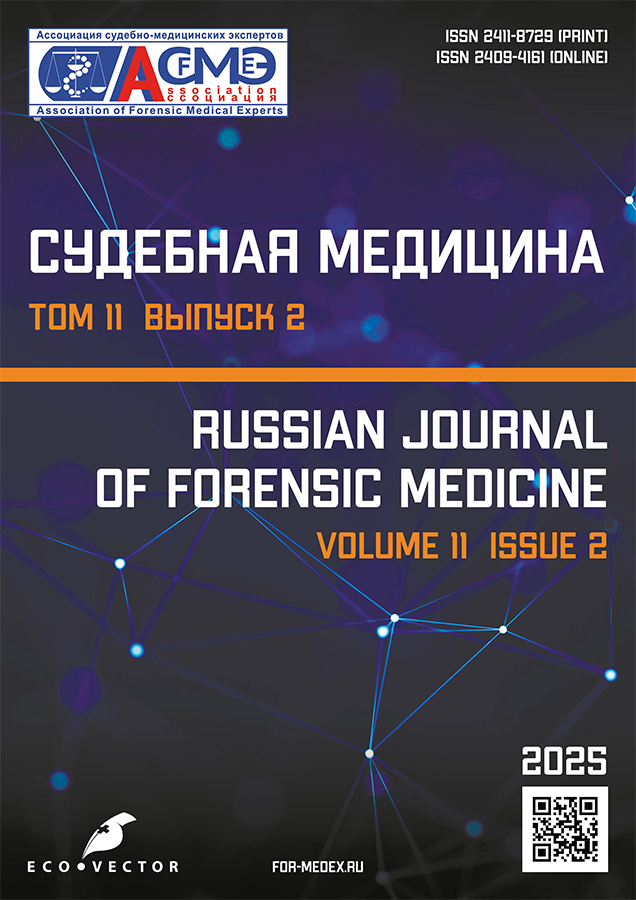Reconstruction of Fall-Related Injury Circumstances: A Case Report
- Authors: Svetlakov A.V.1, Khalikov A.A.2, Sotin A.V.3
-
Affiliations:
- Academician Ye.A. Vagner Perm State Medical University
- Bashkir State Medical University
- Perm National Research Polytechnic University
- Issue: Vol 11, No 2 (2025)
- Pages: 176-184
- Section: Case reports
- Submitted: 04.12.2024
- Accepted: 01.04.2025
- Published: 27.08.2025
- URL: https://for-medex.ru/jour/article/view/16229
- DOI: https://doi.org/10.17816/fm16229
- EDN: https://elibrary.ru/RIXURU
- ID: 16229
Cite item
Abstract
It is not always possible to solve the expert task of determining the circumstances of injury based solely on forensic medical examination findings. In certain cases, analyzing the incident using mathematical calculations allows for the reconstruction of the circumstances under which mechanical trauma occurred.
This paper presents a forensic case that demonstrates the effectiveness of biomechanical (mathematical) analysis as part of a comprehensive forensic biomechanical analysis in reconstructing the circumstances of mechanical trauma resulting from a woman’s fall from the 10th floor under uncertain conditions.
The body of a young woman was discovered on the lawn near a residential building. She had fallen from the balcony window of her apartment on the 10th floor, where she lived with her partner. The Investigative Committee of Russia opened a criminal case based on signs of a potential crime. The woman’s partner claimed she jumped out of the window herself; however, the collected intelligence called his account into question. To address the key investigative question—whether any initial velocity had been imparted to the victim’s body prior to the fall—a comprehensive forensic biomechanical analysis was conducted by forensic medical experts and a mathematical engineer. The constructed mathematical model made it possible to determine which part of the body would have received the impact in the case of a spontaneous fall, i.e., without any external mechanical force. A comparison of the actual medical data and the calculated results revealed that the victim’s body had gained additional initial velocity prior to the fall.
This case demonstrates how a computational experiment can be used as a digital tool to help experts choose between several mechanical injury scenarios.
Full Text
About the authors
Andrey V. Svetlakov
Academician Ye.A. Vagner Perm State Medical University
Author for correspondence.
Email: a_svetlakov@mail.ru
ORCID iD: 0000-0003-3635-6845
SPIN-code: 4066-6630
MD, Cand. Sci. (Medicine), Assistant Professor
Russian Federation, PermAirat A. Khalikov
Bashkir State Medical University
Email: airat.expert@mail.ru
ORCID iD: 0000-0003-1045-5677
SPIN-code: 1895-7300
MD, Dr. Sci. (Medicine), Professor
Russian Federation, UfaAleksandr V. Sotin
Perm National Research Polytechnic University
Email: sotin@mail.ru
ORCID iD: 0000-0003-3889-8023
SPIN-code: 7171-5767
Cand. Sci. (Engineering), Assistant Professor
Russian Federation, PermReferences
- Kovalev AV, Zabrodsky YaD, Samokhodskaya OV. Dynamics of fatal injuries in Russian Federation from 2003 to 2019. Forensic Medical Expertise. 2021;64(4):4–12. doi: 10.17116/sudmed2021640414 EDN: BWHHUL
- Tomilina VV, Pashinyan GA, editors. Manual on forensic medicine. Moscow: Medical; 2001. (In Russ.) ISBN 5-225-04181-7
- Solohin AA, Solohin YuA. Forensic aspects of trauma from a fall from height. Moscow; 1993. (In Russ.)
- Zagryadskaya AP, Tomilin VV, Edlev NS. Theoretical prerequisites for the use of mathematical modelling in forensic identification studies. Forensic Medical Expertise. 1981;24(3):5–8. (In Russ.)
- Sorokin AYu, Plis SS. Algorithm of organisation and production of complex expertise in cases of establishing the mechanism of the victim's fall from a great height. Topical issues of forensic medicine and expert practice. Moscow: AFME; 2018. (In Russ.)
- Shakir'janova JuP, Leonov SV, Pinchuk PV, Sukhareva MA. The possibility of three-dimensional modeling of the mechanisms of damage formation in the framework of situational expertise. Forensic Medical Expertise. 2017;60(6):18–20. doi: 10.17116/sudmed201760618-20 EDN: ZXMHGL
- Leonov SV, Shakir'janova JuP, Sazajeva OV. Mathematical modelling in situational forensic examinations of falls from height. In: Proceedings of the Scientific-Practical Conference "Selected Issues of Forensic Medical Expertise"; 2021 Sep 7–8; Yuzhno-Sakhalinsk. Khabarovsk: Institute for Advanced Training of Healthcare Specialists; 2021. P:92–97. (In Russ.) EDN: NXLJNE
- Leonov SV, Pinchuk SV, Krupin KN, Shakir'janova JuP. Modern and advanced methods of sighting and modelling in accident reconstruction. Avdeev AI, Vlasjuk IV, Trubchik IS, editors. Selected issues of forensic expertise. Кhabarovsk: IPKSZ; 2016. P:134–146. (In Russ.) ISBN: 978-5-98247-067-6 EDN: ZKJZSR
- Leonova EN, Shakir'janova JuP, Leonov SV, et al. Visualization of the reconstruction of a criminal event by means of 3D-modeling. Forensic Medical Expertise. 2018;61(1):52–54. doi: 10.17116/sudmed201861152-54 EDN: QJGZKD
- Shakir'janova JuP. Three-dimensional modelling in forensic medicine: visualisation, identification, reconstruction [dissertation]. Moscow; 2021. (In Russ.). EDN: NQCDAQ
- Buck U, Naether S, Rass B, et al. Accident or homicide-virtual crime scene reconstruction using 3D methods. Forensic Sci. Int. 2013;225(10):75–84. doi: 10.1016/j.forsciint.2012.05.015
- Forensic medical examination of a fall from height: [letter of the Main Forensic Medical Expertise of the RSFSR from 05.05.19900 № /04-01]. M.; 1990. (In Russ.)
- Muggenthaler H, Hubig M, Meierhofer A, Mall G. Slip and tilt: modeling falls over railings. Int. J. Legal Med. 2021;135(1):245–251. doi: 10.1007/s00414-020-02432-8 EDN: MCYJJI
- Lebedev AN. Possibilities of reconstructing some circumstances of fatal fall injury. Forensic Medical Expertise. 1986;29(1):18–21. (In Russ.)
- Adamec J, Jelen K, Kubovy P, et al. Forensic biomechanical analysis of falls from height using numerical human body models. J. Forensic Sci. 2010;55:1615–1623. doi: 10.1111/j.1556-4029.2010.01445.x EDN: NZGPDR
- Muggenthaler H, Drobnik S, Hubig M, et al. Fall from a balcony–accidental or homicidal? Reconstruction by numerical simulation. J. Forensic Sci. 2013;58:1061–1064. doi: 10.1111/1556-4029.12148
- Feola A, Di Mizio G, Francesco LS, et al. Crime scene investigation and dynamic reconstruction: importance of synergic collaboration between forensic pathology and digital reconstruction for work-related fatalities. Cesk. Patol. 2021;57(1):2–5.
- Targ SM. Brief course in theoretical mechanics. M.: HSE University Press; 2010. ISBN: 978-5-06-006193-2 EDN: QJWBVP
- Svetlakov AV. Biomechanical modelling in situational expertise. Bulletin of Forensic Medicine. 2024;13(1):35–41. EDN: HNROPQ
- Svetlakov AV, Selyaninov AA, Sotin AV. Application of mathematical models in solving situational issues in forensic medicine. Perm Medical Journal. 2011;3:110–113. EDN: NXYMMF
Supplementary files









